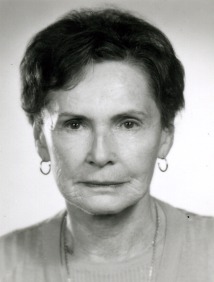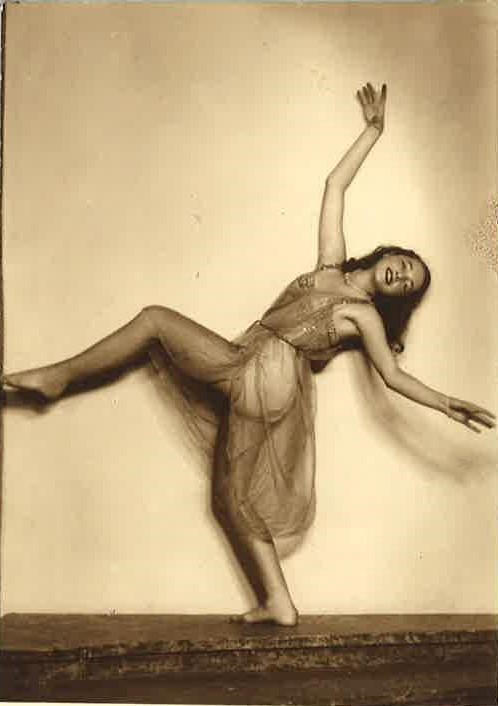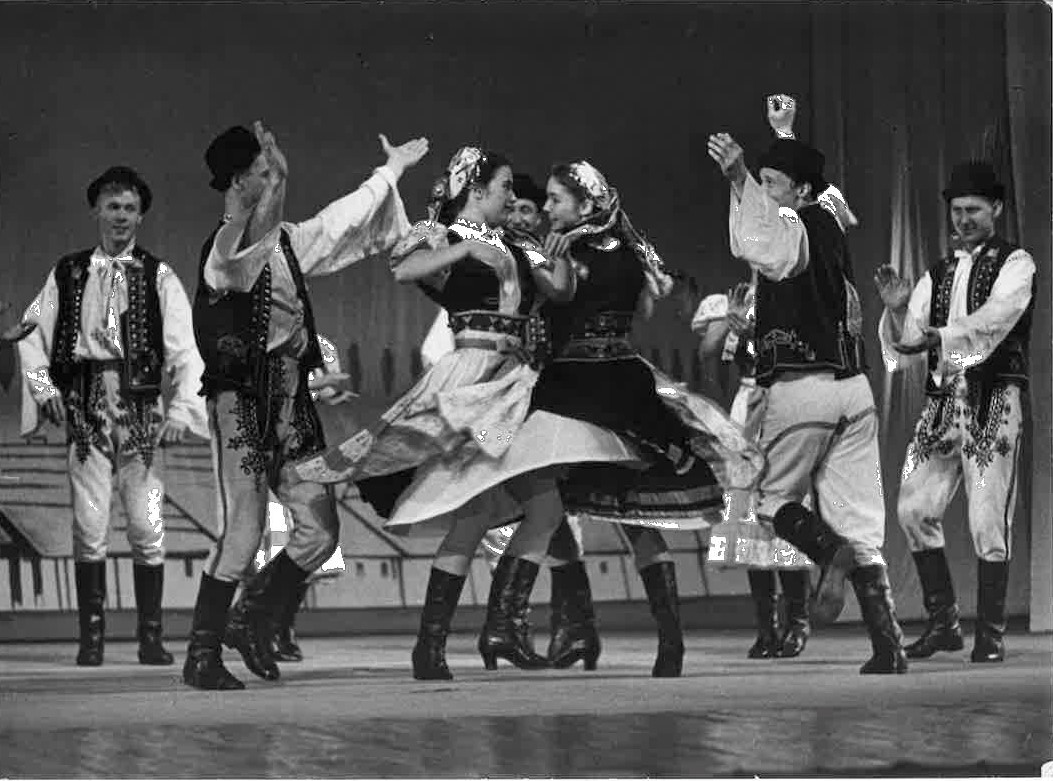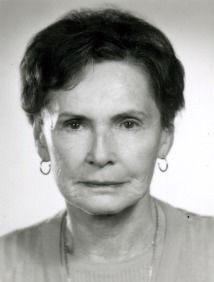 When I was arranging an interview with Jana Hošková, she invited me over to her flat at Prague’s quarter of Letná. I had not shared with her exactly what the topic of our conversation would be, mentioning only that we would certainly talk about the Dance Conservatory, which celebrates an important anniversary. We met one afternoon; there were books laid out on a table in her living room – in case we need to look something up, she said. Jana Hošková is a learned and extremely active lady. When speaking about dancing, she livens up, her eyes light up and there is no doubt that dancing is a passion of her life.
At the beginning, I’d like to ask you an “obligatory” question: How did you get to dancing? In 1930s, 1940s going dancing was still a custom and part of reputation for families...
Of course, it was my mother who introduced me to dancing. The question is rather interesting. I was asked the same by my ballet colleagues in Russia. When I answered that my mother had come from count Colloredo-Mansfeld’s gamekeeper’s lodge in Zbiroh and had been brought up in Gmunden, Austria, they replied: “Yeah, well, she was a Giselle, wasn’t she.” It was funny but true.
Your mother was a dancer?
No, but she was learning to dance and play the violin because, on the hunting occasions, the gamekeeper’s lodge hosted fine companies from far and wide. Dancing used to be a part of nobility’s and kings’ education – they had to know how to move.
Where did you start dancing?
I lived with my parents at Braník. My mother was active in Sokol and coached little children, me included – I was five years old at the time. We performed in the Braník Theatre – Sokol was a great cultural event back then. Some Sokol girls were attending Remislavský’s courses, so I also started commuting across Prague, from Braník all the way to Žižkov, to attend his classes. Remislavský was organizing ballet performances with his school and was designing dances for me, which continued throughout the war.
I read that you also studied with Robert Braun and Marie Tymichová. This was only later?
There is an important thing that I need to share with you: During the war, the dancing and music were the only means of preserving the feelings of spiritual freedom and human dignity. I still remember that our school attended concerts in the Smetana House. There was a big eagle of that size (demonstrates the size) above the stage, under which they played Czech music. We even performed there – I remember dancing the role of a boy in Moravian-Slovak Suite (Slovácká suita). The press could not cover it and one could not talk about it but the performances did take place, just like many other things which went unrecorded, and are thus not known. Perhaps like everybody else, I was greatly influenced by my childhood. Our liberation came when I was still in the fifth year of Gymnasium. The entire world opened for us and I made it to Jindřich Honzl’s National Theatre Studio and attended Robert Braun’s trainings in the Theatre of 5th May (today’s State Opera). Tymichová wasn’t my teacher until later at the Academy of Performing Arts.
Then you danced not only in the Czechoslovak State Ensemble but also in the Military Artistic Ensemble, you led the Artistic Ensemble of the Ministry of the Interior...
In 1948, when I was studying for my school-leaving exam, establishment of the Czechoslovak State Ensemble of Songs and Dances, later nicknamed “stáťas”, was announced. I found it wonderful, which is why I went for the audition. Out of ca. 200 candidates, fifteen girls including myself and fifteen boys were selected. I also considered the Conservatory, which, after the State Ensemble audition, I only went to check out in the end. The committee was the same, headed by Reimoser. It included Zora Šemberová, Saša Machov, only big names.
In 1952, upon request by Radim Drejsl, artistic director at MAS, I left, together with Jan Čumpelík, to render my services to the army. We were supposed to set up a new dance group and produce contemporary military repertoire. At the time, the military service was being joined by graduates of secondary and tertiary art schools, opened after the war. Consequently, several military ensembles were created, varying in artistic orientation. At first, I worked as a choreographer for the Artistic Military Ensemble Prague. After two years it was disbanded and the dance group was transferred to Vít Nejedlý’s Military Artistic Ensemble. Two more years later, I transferred to the Artistic Ensemble of the Ministry of the Interior, being already the dance group leader and choreographer. At the time, Věroslav Neumann asked me to replace Míla Urbanová, who had left for the Conservatory to teach folk dances. The ensemble was a creative workshop for me – I invited Ogoun, Němeček, Towen, Fialka as well as the American Jacqueline Ward. At the time, I was already attending the Academy of Performing Arts. What I discussed there theoretically with Reimoser, I was checking practically in the ensemble.
Besides folk dance, what else was in the repertoire?
We were doing the classics, jazz dance, pantomime, comedy, step, we were looking for new forms.
Was it even possible in the 1950s, which was no easy time?
Indeed, it wasn’t easy, but looking back, the dance movement was forming as early as during the war. In 1943, Edvard Beneš and his exile government attended the premiere of The Bartered Bride in Sadler’s Wells Opera in London, choreographed by Machov. I believe that this is why Beneš was willing to sign the decree on establishment of the Dance Section of the State Conservatory as early as in October 1945, right after the war.
The State Academy is something I wanted to get to...
In its 70 years, the Conservatory has managed to navigate all flows of artistic opinions. I told myself that this is an “anniversary of tenacious perseverance on the road to the edification of spirit by dancing”. I go along with Cunningham’s quote: “You have to love dancing to stick to it. It gives you nothing back, no manuscripts to store away, no paintings to show on walls and maybe hang in museums, no poems to be printed and sold, nothing but that single fleeting moment when you feel alive.” And let me supplement this with the words by Norodom Sihamoni, king of Cambodia and graduate of the Prague Dance Conservatory: “No freedom can approach that obtained by the mastery of the spirit.”
Looking back, I can say that the Dance Conservatory had solid foundations from the day one. There was a strong expressional dance movement here: Milča Mayerová, Jarmila Kröschlová, Laurette Hrdinová, Jarmila Jeřábková, Jožka Šaršeová. The school saw organic mingling of the influence of contemporary dance with the classics; they did not stand in opposition. Only after the revolution some claimed that this was not the case, doing a disservice to our profession. Splitting hairs has probably become a “tradition” in the Czech dance world – this is why, to this day, we have no ballet festival comparable with opera festivals.
I’d like to get back to the folklore, which you pursued intensively. What enchanted you about it?
I wasn’t the only one enchanted. It has enormous inner power. Getting to know the folk dance in the field was an adventure. I studied various environments, observing all impacts on the dance style: music, shape of attire, type of shoes, cultural traditions, social relations. When designing The Dove (Holubička) and Little-Clogs Dance (Dřeváčkový tanec), my first prize winners in 1955 and 1957, respectively, my intention was not only to demonstrate dance steps in the folk dance – I also attempted to apply their expressional potential and to express changing interrelations through dancing. At the time, individual dance genres influenced one another. I remember how in Kvasice, where the Artistic Board of the State Ensemble had its regular meetings and we were demonstrating what we had learned, Saša Machov and the artist Věra Fridrichová did a great performance of the “sedlácká” dance.
When I was arranging an interview with Jana Hošková, she invited me over to her flat at Prague’s quarter of Letná. I had not shared with her exactly what the topic of our conversation would be, mentioning only that we would certainly talk about the Dance Conservatory, which celebrates an important anniversary. We met one afternoon; there were books laid out on a table in her living room – in case we need to look something up, she said. Jana Hošková is a learned and extremely active lady. When speaking about dancing, she livens up, her eyes light up and there is no doubt that dancing is a passion of her life.
At the beginning, I’d like to ask you an “obligatory” question: How did you get to dancing? In 1930s, 1940s going dancing was still a custom and part of reputation for families...
Of course, it was my mother who introduced me to dancing. The question is rather interesting. I was asked the same by my ballet colleagues in Russia. When I answered that my mother had come from count Colloredo-Mansfeld’s gamekeeper’s lodge in Zbiroh and had been brought up in Gmunden, Austria, they replied: “Yeah, well, she was a Giselle, wasn’t she.” It was funny but true.
Your mother was a dancer?
No, but she was learning to dance and play the violin because, on the hunting occasions, the gamekeeper’s lodge hosted fine companies from far and wide. Dancing used to be a part of nobility’s and kings’ education – they had to know how to move.
Where did you start dancing?
I lived with my parents at Braník. My mother was active in Sokol and coached little children, me included – I was five years old at the time. We performed in the Braník Theatre – Sokol was a great cultural event back then. Some Sokol girls were attending Remislavský’s courses, so I also started commuting across Prague, from Braník all the way to Žižkov, to attend his classes. Remislavský was organizing ballet performances with his school and was designing dances for me, which continued throughout the war.
I read that you also studied with Robert Braun and Marie Tymichová. This was only later?
There is an important thing that I need to share with you: During the war, the dancing and music were the only means of preserving the feelings of spiritual freedom and human dignity. I still remember that our school attended concerts in the Smetana House. There was a big eagle of that size (demonstrates the size) above the stage, under which they played Czech music. We even performed there – I remember dancing the role of a boy in Moravian-Slovak Suite (Slovácká suita). The press could not cover it and one could not talk about it but the performances did take place, just like many other things which went unrecorded, and are thus not known. Perhaps like everybody else, I was greatly influenced by my childhood. Our liberation came when I was still in the fifth year of Gymnasium. The entire world opened for us and I made it to Jindřich Honzl’s National Theatre Studio and attended Robert Braun’s trainings in the Theatre of 5th May (today’s State Opera). Tymichová wasn’t my teacher until later at the Academy of Performing Arts.
Then you danced not only in the Czechoslovak State Ensemble but also in the Military Artistic Ensemble, you led the Artistic Ensemble of the Ministry of the Interior...
In 1948, when I was studying for my school-leaving exam, establishment of the Czechoslovak State Ensemble of Songs and Dances, later nicknamed “stáťas”, was announced. I found it wonderful, which is why I went for the audition. Out of ca. 200 candidates, fifteen girls including myself and fifteen boys were selected. I also considered the Conservatory, which, after the State Ensemble audition, I only went to check out in the end. The committee was the same, headed by Reimoser. It included Zora Šemberová, Saša Machov, only big names.
In 1952, upon request by Radim Drejsl, artistic director at MAS, I left, together with Jan Čumpelík, to render my services to the army. We were supposed to set up a new dance group and produce contemporary military repertoire. At the time, the military service was being joined by graduates of secondary and tertiary art schools, opened after the war. Consequently, several military ensembles were created, varying in artistic orientation. At first, I worked as a choreographer for the Artistic Military Ensemble Prague. After two years it was disbanded and the dance group was transferred to Vít Nejedlý’s Military Artistic Ensemble. Two more years later, I transferred to the Artistic Ensemble of the Ministry of the Interior, being already the dance group leader and choreographer. At the time, Věroslav Neumann asked me to replace Míla Urbanová, who had left for the Conservatory to teach folk dances. The ensemble was a creative workshop for me – I invited Ogoun, Němeček, Towen, Fialka as well as the American Jacqueline Ward. At the time, I was already attending the Academy of Performing Arts. What I discussed there theoretically with Reimoser, I was checking practically in the ensemble.
Besides folk dance, what else was in the repertoire?
We were doing the classics, jazz dance, pantomime, comedy, step, we were looking for new forms.
Was it even possible in the 1950s, which was no easy time?
Indeed, it wasn’t easy, but looking back, the dance movement was forming as early as during the war. In 1943, Edvard Beneš and his exile government attended the premiere of The Bartered Bride in Sadler’s Wells Opera in London, choreographed by Machov. I believe that this is why Beneš was willing to sign the decree on establishment of the Dance Section of the State Conservatory as early as in October 1945, right after the war.
The State Academy is something I wanted to get to...
In its 70 years, the Conservatory has managed to navigate all flows of artistic opinions. I told myself that this is an “anniversary of tenacious perseverance on the road to the edification of spirit by dancing”. I go along with Cunningham’s quote: “You have to love dancing to stick to it. It gives you nothing back, no manuscripts to store away, no paintings to show on walls and maybe hang in museums, no poems to be printed and sold, nothing but that single fleeting moment when you feel alive.” And let me supplement this with the words by Norodom Sihamoni, king of Cambodia and graduate of the Prague Dance Conservatory: “No freedom can approach that obtained by the mastery of the spirit.”
Looking back, I can say that the Dance Conservatory had solid foundations from the day one. There was a strong expressional dance movement here: Milča Mayerová, Jarmila Kröschlová, Laurette Hrdinová, Jarmila Jeřábková, Jožka Šaršeová. The school saw organic mingling of the influence of contemporary dance with the classics; they did not stand in opposition. Only after the revolution some claimed that this was not the case, doing a disservice to our profession. Splitting hairs has probably become a “tradition” in the Czech dance world – this is why, to this day, we have no ballet festival comparable with opera festivals.
I’d like to get back to the folklore, which you pursued intensively. What enchanted you about it?
I wasn’t the only one enchanted. It has enormous inner power. Getting to know the folk dance in the field was an adventure. I studied various environments, observing all impacts on the dance style: music, shape of attire, type of shoes, cultural traditions, social relations. When designing The Dove (Holubička) and Little-Clogs Dance (Dřeváčkový tanec), my first prize winners in 1955 and 1957, respectively, my intention was not only to demonstrate dance steps in the folk dance – I also attempted to apply their expressional potential and to express changing interrelations through dancing. At the time, individual dance genres influenced one another. I remember how in Kvasice, where the Artistic Board of the State Ensemble had its regular meetings and we were demonstrating what we had learned, Saša Machov and the artist Věra Fridrichová did a great performance of the “sedlácká” dance.
 You studied dance theory with Professor Jan Reimoser. You were one of his first graduates. How did he influence you?
I did have one predecessor: Bíba Brodská. Reimoser led us to see and also experience what we talked and wrote about. I danced through all styles, I was commuting to Palucca Schule, I attended a pantomime course. Reimoser was a tremendously matter-of-fact, completely pragmatical person. He had a great library full of foreign literature on dancing and we kept on translating. Prague and Bratislava saw creation of dance theory at the time. Theory required full interconnection with practice; dance science already seems to me somewhat detached from the material basis of dancing. Going around regional theatres, we watched all premieres and then discussed them.
In 1963 you stopped dancing and became editor-in-chief in Taneční listy. How did that come to pass?
Reimoser managed to relaunch the Taneční listy journal, issued for the last time in 1952, and asked me to take charge. I wasn’t particularly fond of the idea but he persuaded me. He knew that I had pursued various dance disciplines, was familiar with my opinions: There is only one human body and all genres must be rendered in a physiologically correct manner in different styles.
What do you consider to be most important for a professional dancer’s education?
Dancing is a demanding profession, with contemporary development reaching for the bounds of physical possibility. A dancer must command a range of techniques, styles, methods. They must be able to work with their body, know it well and be aware of their own head, too, i.e. to feel emotions.
What are your memories of Taneční listy, where you worked for almost thirty years? This is where you lived through spring 1968, the normalization period... Did you experience any political pressures at work? Was it possible to subject especially the Soviet Union production to open criticism? Was it possible to travel abroad?
Dancing in general has certain opponents regardless of political regimes – some problems are identical regardless of the regime. There are two kinds of people: the first kind pursues something – which for me was dancing –, the other kind fights something. By pursuing dancing I also went against what depressed me. Starting in Taneční listy, I wanted to see the developments abroad, see American ballet. I travelled to the USA with a Čedok tour, which I paid for myself. It was in 1964 and I was given a letter of recommendation from the editorial board. The group comprised e.g. Arnošt Lustig, Bohumil Hrabal, Jaroslav Dietl; I spent there three weeks. In New York I met Balanchine for the first time. It was in the Russian Tea Room, with waiters dressed in rubashkas, Ballets russes posters on the walls... And I wanted to get to know America. I gave an interview to Dance News about Czech ballet. They wanted to take pictures of me, and I gave them photos of Marcela Martiníková and Rudolf Brom instead, of Studio Ballet Prague, who were more important.
For no pay I was writing promotional materials on Czech ballet and sending them abroad, which was my way of networking. I even received an invitation to an international competition in Japan, which comprised Czech dancers. However, the Ministry of Culture did not support my trip, and I could not leave. Soon after, the Japanese cultural attaché invited me over to the embassy; he was interested in how the competition went. He had no idea that my invitation had been used to send somebody else, which he couldn’t understand and said: “This is not how it works in Japan. You need to go after your demand and assert your right.” But I made it to festivals in Cuba, where I was invited by Alicia Alonso, who staged La fille mal gardée in the National Theatre in 1980.
You admire Marius Petipa, George Balanchine. What is it that fascinates you about them?
I also like Frederick Ashton. They gave a lot to ballet and were modest. I met both of them in person. I also attended a seminar on the occasion of Balanchine’s 100th anniversary in Saint Petersburg, where Americans from the Balanchine Trust were also present. The seminar concluded that Balanchine’s technique is a pre-Vaganova tsarist ballet technique. The American ladies were saying: “We thought that Balanchine belonged to us only.”
You studied dance theory with Professor Jan Reimoser. You were one of his first graduates. How did he influence you?
I did have one predecessor: Bíba Brodská. Reimoser led us to see and also experience what we talked and wrote about. I danced through all styles, I was commuting to Palucca Schule, I attended a pantomime course. Reimoser was a tremendously matter-of-fact, completely pragmatical person. He had a great library full of foreign literature on dancing and we kept on translating. Prague and Bratislava saw creation of dance theory at the time. Theory required full interconnection with practice; dance science already seems to me somewhat detached from the material basis of dancing. Going around regional theatres, we watched all premieres and then discussed them.
In 1963 you stopped dancing and became editor-in-chief in Taneční listy. How did that come to pass?
Reimoser managed to relaunch the Taneční listy journal, issued for the last time in 1952, and asked me to take charge. I wasn’t particularly fond of the idea but he persuaded me. He knew that I had pursued various dance disciplines, was familiar with my opinions: There is only one human body and all genres must be rendered in a physiologically correct manner in different styles.
What do you consider to be most important for a professional dancer’s education?
Dancing is a demanding profession, with contemporary development reaching for the bounds of physical possibility. A dancer must command a range of techniques, styles, methods. They must be able to work with their body, know it well and be aware of their own head, too, i.e. to feel emotions.
What are your memories of Taneční listy, where you worked for almost thirty years? This is where you lived through spring 1968, the normalization period... Did you experience any political pressures at work? Was it possible to subject especially the Soviet Union production to open criticism? Was it possible to travel abroad?
Dancing in general has certain opponents regardless of political regimes – some problems are identical regardless of the regime. There are two kinds of people: the first kind pursues something – which for me was dancing –, the other kind fights something. By pursuing dancing I also went against what depressed me. Starting in Taneční listy, I wanted to see the developments abroad, see American ballet. I travelled to the USA with a Čedok tour, which I paid for myself. It was in 1964 and I was given a letter of recommendation from the editorial board. The group comprised e.g. Arnošt Lustig, Bohumil Hrabal, Jaroslav Dietl; I spent there three weeks. In New York I met Balanchine for the first time. It was in the Russian Tea Room, with waiters dressed in rubashkas, Ballets russes posters on the walls... And I wanted to get to know America. I gave an interview to Dance News about Czech ballet. They wanted to take pictures of me, and I gave them photos of Marcela Martiníková and Rudolf Brom instead, of Studio Ballet Prague, who were more important.
For no pay I was writing promotional materials on Czech ballet and sending them abroad, which was my way of networking. I even received an invitation to an international competition in Japan, which comprised Czech dancers. However, the Ministry of Culture did not support my trip, and I could not leave. Soon after, the Japanese cultural attaché invited me over to the embassy; he was interested in how the competition went. He had no idea that my invitation had been used to send somebody else, which he couldn’t understand and said: “This is not how it works in Japan. You need to go after your demand and assert your right.” But I made it to festivals in Cuba, where I was invited by Alicia Alonso, who staged La fille mal gardée in the National Theatre in 1980.
You admire Marius Petipa, George Balanchine. What is it that fascinates you about them?
I also like Frederick Ashton. They gave a lot to ballet and were modest. I met both of them in person. I also attended a seminar on the occasion of Balanchine’s 100th anniversary in Saint Petersburg, where Americans from the Balanchine Trust were also present. The seminar concluded that Balanchine’s technique is a pre-Vaganova tsarist ballet technique. The American ladies were saying: “We thought that Balanchine belonged to us only.”
You had a family – two daughters – and demanding editorial work. How were you coping with it?
Well, poor girls. My mother was helping me out. This is why I babysit my grandson now and enjoy it. I couldn’t even chaperon my daughter to the dancing lessons. I was alone in the editorial office.
In 1989 you left Taneční listy... What did you do afterwards?
I felt sorry, but looking at the bound volume of the journal (she picks it up), I think to myself: What an achievement...; even though the paper was no good. In 1988 I fell down walking the metro stairs, breaking my kneecap. Temporarily disabled, I had to push back the next issue, which served as a pretext for giving me my notice. At the time, I was cooperating with Eva Blažíčková on establishment of the Duncan Centre; I was working for school inspection. But I suppose Fortune favours the prepared mind. I speak Russian, English, German. I have always been fond of travelling, which is why I passed a guide course exam. I travelled to Egypt, Israel, Great Britain and other countries. In jest, I claim that the new times saw me emigrate. When you want to see a dance performance, you need to travel and this is what I was doing again. And just like dancing, travelling was my means of discovering the world.
You still write about dancing, follow dancing events in our country as well as in the world. Can our ballet – the National Theatre Prague Ballet, the National Theatre Brno Ballet ensembles – stand comparison with the foreign ballet?
Ballet is a complicated environment. Its tools are people, who must be educated; in their background, there are choreographers, authors. As Maurice Béjart said, each choreographer should also be a philosopher. After the Velvet Revolution, everything got tangled – a number of dancers had to leave, even though they were solo dancers. I found that sad, just like the proclamations that the Russian ballet would be done with. I don’t think any foreigner would come over to see the new versions of the classical ballets which I get to watch here these days.


What would you wish to the Dance Conservatory on the occasion of its 70th anniversary?
In 1968, when Prague hosted the renowned ballet critic Horst Koegler from Cologne, representative of Das Tanzarchiv, Deutsche Zeitschrift für Tanzkunst und Folklore journal, I interviewed him for Taneční listy; the interview was titled Horst Koegler answering to Taneční listy. Koegler thought highly of the Prague Dance Conservatory and its pupils, claiming even that all of its graduates and many students could leave for the Federal Republic of Germany that very minute and get engaged in its ballet ensembles. That was a great compliment coming from an expert familiar with ballet standards in the world. However, in Taneční listy the extensive interview was reduced to a modest double spread, hastily supplemented with a photo from Merce Cunningham’s performance to top it all. This was because I was summoned to the Press Supervision HeadAdministration, where the entire passage dealing with the school was scratched out. They said it was basically an invitation for Czech ballet artists to emigrate. A number of the Prague Dance Conservatory graduates did emigrate, anyway: Vladimír Kloc, Petr Vondruška, Ivan Liška, Jan Minařík, Jiří Kylián. Stanislav Buzek and Otta Zajíc had already worked in Düsseldorf’s Deutsche Oper am Rhein since 1963. They used to send me a lot of press material for Taneční listy. The situation has changed since; today’s dancers can choose their engagements without restrictions but they face great competition. Therefore, I wish the Dance Conservatory to keep its perseverance on the road to the edification of spirit by dancing.
Jana Hošková (1929), dancer, choreographer, teacher, critic and publicist. Studied with Remislav Remislavský, Robert Braun, Marie Tymichová. In 1960 she completed her Dance Theory studies at the Department of Dance, Theatre Faculty of the Academy of Performing Arts in Prague; in 1961 and 1962 she studied aesthetics at the Faculty of Arts, Charles University. She had a number of engagements: National Theatre Prague Studio 1946/1947, Czechoslovak State Ensemble of Songs and Dances 1948–1952, choreographer in Vít Nejedlý’s Military Artistic Ensemble, dance group leader in the Artistic Ensemble of the Ministry of the Interior 1956–1964. In 1963–1989 she was editor-in-chief of Taneční listy. She authored numerous choreographies, dance reconstructions and stylized folk dances, staging e.g. The Dove (Holubička, first prize winner at the 1955 World Festival of Youth and Students in Warsaw), Little-Clogs Dance (Dřeváčkový tanec, first prize winner at the World Festival of Youth and Students in Moscow). She worked as an external teacher at the Music and Dance Faculty of the Academy of Performing Arts in Prague and led the Duncan Centre Conservatory archives (1991–1993). Since 1956 she has been publishing in the daily press and domestic as well as foreign professional journals. (Source: Dictionary of Dance, Arts and Theatre Institute [Taneční slovník, Divadelní ústav] 2001)
Translation: Petr Štádler





Josef Bartos
Thank you for your thoughts. One got stuck in my mind – that passion makes us different from AI. Just yesterday I read…I am a dance critic. I am a member of an endangered species